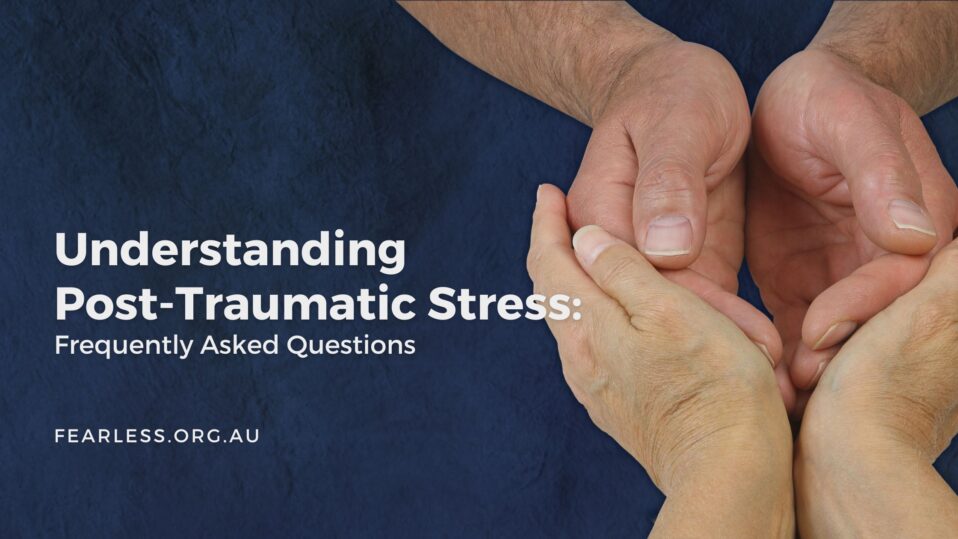Post traumatic stress can occur after a person experiences or witnesses a distressing or life-threatening event. It can follow incidents such as an accident, assault, natural disaster or combat exposure. While some people recover naturally, others continue to experience flashbacks, anxiety, and emotional numbness long after the event.
When these feelings persist and begin to affect daily life, it may be post traumatic stress disorder (PTSD). At FearLess, we use the term post traumatic stress because we believe everyone living with the effects of trauma deserves support—whether or not they have a formal diagnosis. Our mission is to restore control to people living with traumatic stress by providing information, connection and hope.
You can learn more about our work at www.fearless.org.au.
Who experiences post traumatic stress
Post traumatic stress can affect anyone. It is not limited to military personnel or first responders. It can develop after experiences such as family violence, crime, natural disasters, or serious accidents. People from all walks of life—including veterans, Indigenous communities, refugees, and those in regional areas—can be affected.
According to the Australian Institute of Health and Welfare, around 57 to 75 per cent of Australians will experience a potentially traumatic event in their lifetime, and more than one million Australians are currently living with PTSD. Women are at twice the risk of men.
At FearLess, we believe in breaking down stigma, building understanding and ensuring every story is heard. Trauma touches families, workplaces and communities—and healing requires compassion and connection.
What are the common signs and symptoms
Each person’s experience is unique, but there are several signs that may indicate post traumatic stress. These can include:
-
Reliving a traumatic event through flashbacks or nightmares
-
Avoiding reminders, people or places connected to the event
-
Feeling constantly alert or “on edge”
-
Difficulty sleeping or concentrating
-
Emotional numbness or withdrawal
-
Persistent sadness, anger or guilt
-
Using drugs or alcohol to cope
Recognising the signs early and seeking help is important. Support is available, and recovery begins by reaching out.
How is post traumatic stress treated
Effective treatment often combines therapy, education and community support. Approaches like cognitive behavioural therapy (CBT), eye movement desensitisation and reprocessing (EMDR), and trauma-informed counselling are commonly used. Some people also benefit from group programs, mindfulness, physical activity, or creative therapies.
The key is connection—between health professionals, families, and community networks. FearLess helps build these connections by bringing together the 3,500 organisations across Australia working with people living with post traumatic stress. You can read about our approach to collaboration on our About Us page.
Can people recover from post traumatic stress
Yes. With the right treatment and support, many people recover and go on to live fulfilling lives. Recovery doesn’t mean forgetting the trauma—it means learning how to manage its impact and rebuild a sense of safety and confidence.
At FearLess, we work to make recovery possible through education, advocacy and community connection. We share evidence-based research and highlight treatments and resources that help people regain control of their lives.
How can you support someone living with post traumatic stress
Support starts with understanding. You don’t need to have all the answers—just being there, listening, and showing empathy can help. Encourage the person to seek professional help if they haven’t already, and remind them that recovery is possible.
For more background on the condition and support options, you can also read PsychCentral’s PTSD FAQ.
What is FearLess doing to help
FearLess PTSD Australia & New Zealand is a registered charity working to reduce the impact of trauma by building understanding and access to support. We facilitate national conversations, share lived experiences and promote research to strengthen community awareness.
Our vision is to bring together individuals, organisations and professionals to form a unified response to post traumatic stress across Australia and New Zealand. Through our education series, events and partnerships, we aim to normalise conversation around trauma and ensure that everyone living with post traumatic stress can access the help they need.
Join the FearLess community
If you or someone you know is living with post traumatic stress, you are not alone. By joining the FearLess community, you can access reliable information, connect with others who understand, and help us raise awareness and drive change.
Visit fearless.org.au to:
-
Join our community and take part in events
-
Access resources and learn more about recovery
-
Donate or partner with us to support our mission
Together, we can restore control and build a future where every person living with trauma has the support they deserve.



Post a comment